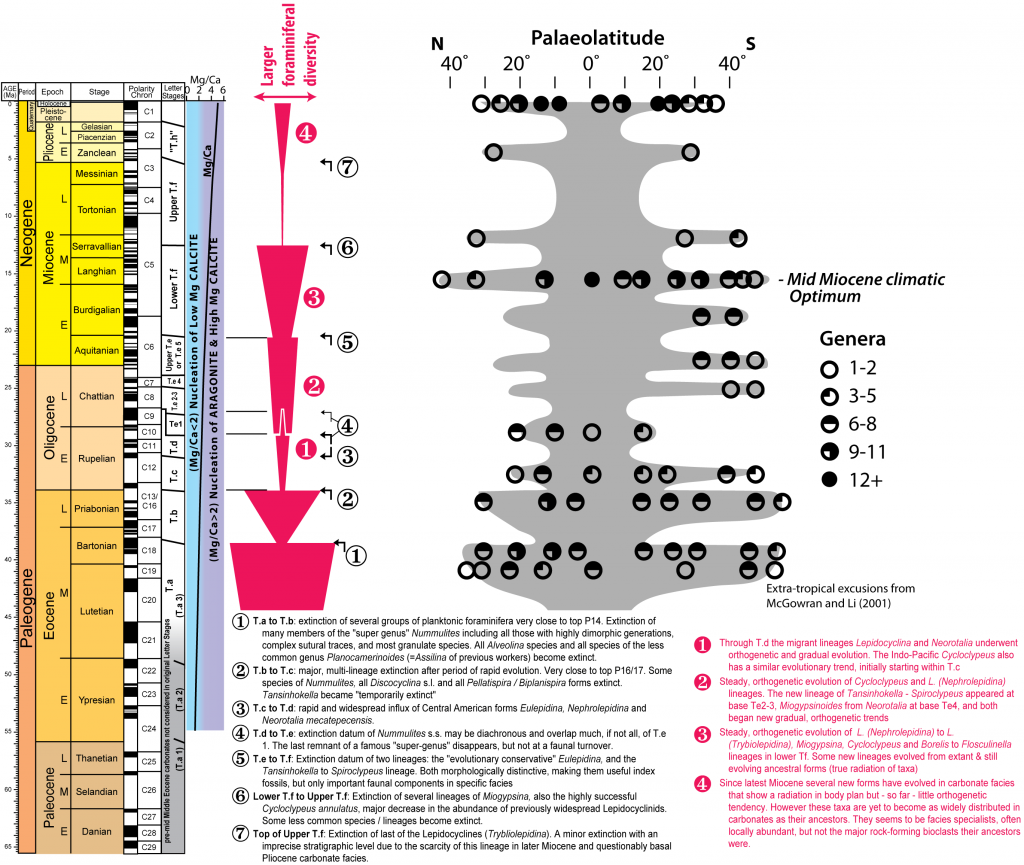Lunt, P., 2021. Biological evolution of SE Asian carbonates, based on their microfossil content. SEPM Special publication, Cenozoic Isolated Carbonate Platforms – Focus Southeast Asia, doi:10.2110/sepmsp.114.07
This was the third of three papers for an SEPM Special Publication on “Cenozoic Isolated Carbonate Platforms – Focus Southeast Asia” to remedy some of these issues. The others were on carbonates in regional stratigraphy and Luconia carbonates.
This paper attempted to correct inputs to previous work and set out a new concept for the evolution of carbonate systems in SE Asia. It is known that older Miocene oceans were changing from calcitic to aragonitic and that there was regional climate change (a seasonal climate to the ever-wet conditions that persists until today) as well as constriction of the throughflow from the Pacific to Indian Oceans. Previous plots of the ages of coralline reefs were in error and it could be shown that there was no abrupt change from larger foraminifera and coral to dominantly coral reefs associated with the climate change on the Oligo-Miocene boundary. It could also be shown that regional extension did not change to compression at the same time, as the Oligo-Miocene event was a dominantly extensional event with widespread subsidence (Luan and Lunt 2021a, 2021b).
The paper then looked at the palaeontological record of the calcitic larger foraminifera (which are much better preserved than the aragonitic fossils). It was noted that such larger foraminifera facies seem to have gradually been marginalised during the older Miocene, as coral-mollusc faunas became more common in the bioherms. However the larger foraminifera seemed to diversify even during this gradually reduced role as carbonate bioclasts, but were subject to period mass-extinctions. Most of these correlated to times of tectonic change but a simple correlation was confused. One of the most extensive tectonic events, on the Oligo-Miocene boundary, had no effect on larger foraminifera, and the extinction on the Eocene-Oligocene boundary was likely a global climatic event. Its co-occurrence with tectonism across SE Asia (discussed in the regional paper) appears to have been a coincidence.
The paper includes important new data on the age of the top Letter Stage Te and the Lower Tf to Upper Tf mass extinction event. The theme of the evolution of the larger foraminifera, Tethyan stratigraphy and the causes of mass extinctions has been continued in a new paper by Lunt and Luan for a special larger benthic foraminifera issue of The Journal of Earth Science in prep

References
Luan, X., Lunt, P., 2021.a Eocene to Miocene stratigraphic controls in the far East Java Sea: Implications for stratigraphic studies. Marine Geology 436, 106479
Luan, X., Lunt, P., 2021b. Latest Eocene and Oligocene tectonic controls on carbonate deposition in eastern Java and the south Makassar Straits, Indonesia. Journal of Asian Earth Sciences,
Be First to Comment